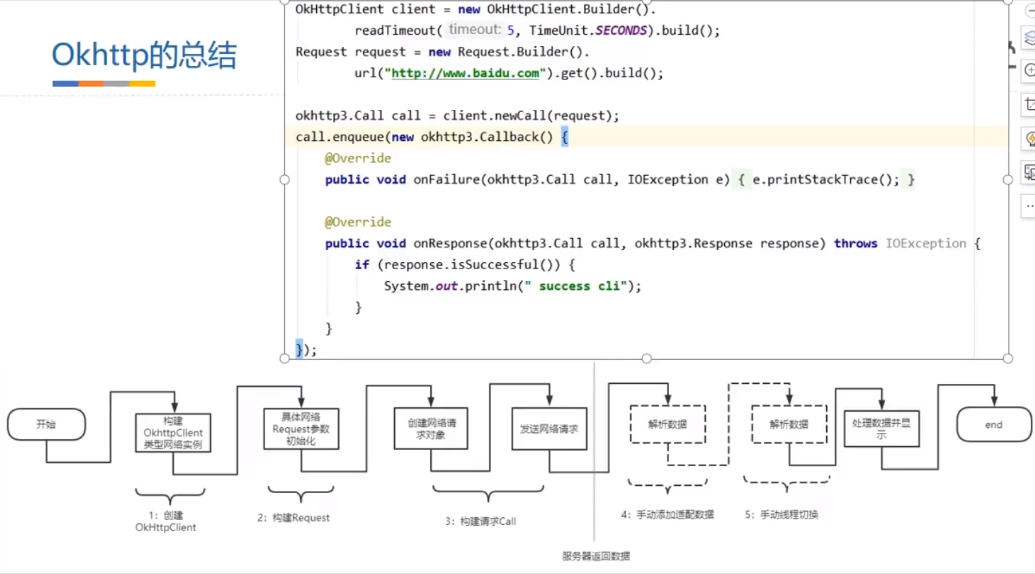1.简单介绍
retrofit事实上就是对okhttp做了进一步一层封装优化。
我们仅仅须要通过简单的配置就能使用retrofit来进行网络请求了。
Retrofit能够直接返回Bean对象,比如假设我们进行一个网络接口的请求。返回来一串json字符串。那么这个时候一般我们都要拿到这个json字符串后进行解析得到相应的Bean对象,Retrofit仅仅要依赖一下Gson的转换库然后进行简单的配置就能够直接拿到Bean对象了,不须要我们自己去解析。
接触过OKHttp的人会发现,Retrofit和OKHttp的代码有些地方有很大的类似度。
他的性能很的棒,国外大牛(被墙了)已经做过測例如以下图:

看了这个图之后你有什么想法?
Talk is cheap, show me the code!
!
2.高速使用
在实际项目开发中get、post请求使用居多。那我们以get请求来做个入门小案例。
http://ip.taobao.com/service/getIpInfo.php?ip=8.8.8.8
以上连接是一个get请求方式。參数在地址后面使用“?”进行名值对的拼接。请求的结果是一个json字符串数据。例如以下
{"code":0,"data":{"country":"\u7f8e\u56fd","country_id":"US","area":"","area_id":"","region":"","region_id":"","city":"","city_id":"","county":"","county_id":"","isp":"","isp_id":"","ip":"8.8.8.8"}}
来个简单的Demo界面例如以下:
功能很easy,一个输入框输入IP地址,然后获取IP地址所在的国家。

1)环境的配置
如今预计很少人用eclipse做项目开发了。eclipse的方式就不另赘述了(GitHub上也是有jar依赖下载的)。我们这里的开发工具是用的Android Studio,在 GitHub项目地址:https://github.com/square/retrofit能够找到Gradle的依赖代码:
加入两个依赖:retrofit依赖。和gson转换器。
compile 'com.squareup.retrofit2:retrofit:2.1.0'//眼下最新的版本号
compile 'com.squareup.retrofit2:converter-gson:2.1.0'//加入好这个依赖后我们就能够进行数据转换器的配置了。retrofit内部就会帮我们去转换json字符串为Java对象
在AS里面的效果例如以下:
converter-gson依赖的版本号号与retrofit依赖版本号号保持一致。我们在GitHub上能够看到。他们在同一个project里面的。
2)代码
布局很easy就不另贴代码了。类也不多參看以下的包结构图
Retrofit操作步骤
① 先把接口返回来的数据bean对象写好。
能够直接使用工具转化。如GsonFormat工具
public class IpInfo {
public int code;
public DataBean data;
public static class DataBean {
public String country;
public String country_id;
public String area;
public String area_id;
public String region;
public String region_id;
public String city;
public String city_id;
public String county;
public String county_id;
public String isp;
public String isp_id;
public String ip;
}
}
② 定义API接口
一般来讲都是处理遵循RESTful接口规范的http接口,我们须要把接口转化为Java Interface。
/**
* 这个接口就是普通的借口类,可是看到里面的方法来,会有一些注解定义相关的功能
* 如@GET定义请求方式为get请求方式,假设有參数能够使用@Query、@QueryMap定义
*/
public interface IpService {
/**
* @return 固定返回值为Call。当中泛型指定是进行请求后返回终于得数据类型。
③ 初始化Retrofit,创建接口实例,进行异步请求
代码凝视灰常仔细了
/**
*Retrofit简单有用案例
*
* 採用http://ip.taobao.com/service/getIpInfo.php?ip=202.178.10.2 地址进行查询
*/
public class MainActivity extends AppCompatActivity {
public static final String baseUrl = "http://ip.taobao.com/service/";
private TextView tvResult;
private EditText etIp;
IpService ipService;
@Override
protected void onCreate(Bundle savedInstanceState) {
super.onCreate(savedInstanceState);
setContentView(R.layout.activity_main);
tvResult = (TextView) findViewById(R.id.tv_result);
etIp = (EditText) findViewById(R.id.et_ip);
initRetrofit();
}
/**
* 初始化Retrofit实例。并创建接口类。
* 注意:IpService不须要我们去实现。直接Retrofit=类有create方法生成。
*/
private void initRetrofit() {
//创建Retrofit的实例,把Gson转换器设置下
Retrofit retrofit = new Retrofit
.Builder()
.baseUrl(baseUrl)//设置API的基础地址
.addConverterFactory(GsonConverterFactory.create())//设置后才才支持json字符串转化为Bean
.build();
//使用Retrofit的create方法传入创建接口实例
ipService = retrofit.create(IpService.class);
}
/**
* 布局中查询button配置的点击事件
* @param view
*/
public void check(View view) {
String ip = etIp.getText().toString();
if (TextUtils.isEmpty(ip)) {
Toast.makeText(this, "ip 不能为空", Toast.LENGTH_SHORT).show();
return;
}
//调用接口声明的方法
Call<IpInfo> ipInfoCall = ipService.getIpInfo(ip);
//call能够直接调用异步方法。进行结果获取。须要传入接口回调Callback,
ipInfoCall.enqueue(new Callback<IpInfo>() {
@Override
public void onResponse(Call<IpInfo> call, Response<IpInfo> response) {
//推断网络请求是否成功。网络请求返回code为[200..300)那么与后台连接成功。否则连接失败
if (response.isSuccessful()) {
//直接拿到JavaBean
IpInfo ipInfo = response.body();
//这里直接能够进行UI操作。OKHttp是不行的哦
tvResult.setText(ipInfo.getData().getCountry());
} else {
//请求失败。
3.经常使用注解
GET:get 请求方式
POST:post请求方式
Query:定义get请求參数
QueryMap:定义get请求參数
Field:定义post请求參数
FieldMap:定义post请求參数
Header:定义头參数
HeaderMap:定义头參数
Headers:定义头參数
Path:动态路径
来看看代码是怎么实现的:
public interface SampleApi {
//----------------------GET 请求方式 start --------------------------------
/**
* 注解:GET。QUERY,QUERYMAP 的使用
*/
/**
* get 请求固定參数形式
*
* @return
*/
@GET("demo?username=zhanghsan&password=123455")
Call<SampleResponse> getFun();
/**
* 使用@Query注解进行參数传递
*
* @param username
* @param password
* @return
*/
@GET("demo")
Call<SampleResponse> getFun(@Query("username") String username, @Query("password") String password);
/**
* 使用@QueryMap注解 Map集合进行參数传递
*
* @param params
* @return
*/
@GET("demo")
Call<SampleResponse> getFun(@QueryMap Map<String, Object> params);
//----------------------GET 请求方式 end --------------------------------
//----------------------POST 请求方式 start --------------------------------
/**
* POST,Field,FieldMap,FormUrlEncoded(POST 方式请求有參数的时候一定不要忘记了这个注解)
*/
/**
* post使用@Query注解进行參数传递
*
* @param username
* @param password
* @return
*/
@FormUrlEncoded
@POST("demo")
Call<SampleResponse> postFun(@Field("username") String username, @Field("password") String password);
/**
* POST使用@FiledMap Map集合进行參数传递
*
* @param params
* @return
*/
@FormUrlEncoded
@POST("demo")
Call<SampleResponse> postFun(@FieldMap Map<String, Object> params);
//----------------------POST 请求方式 end --------------------------------
//----------------------head參数加入start --------------------------------
/**
* Headers。Header,HeaderMap
* */
/**
* 有些接口须要传送一些操作client系统的信息,比方系统类型。系统版本号等例如以下
*
* @param username
* @param password
* @return
*/
@Headers(
{"os:Android"
, "osversion:5.0"
})
@FormUrlEncoded
@POST("demo")
Call<SampleResponse> postFunWithHead(@Field("username") String username, @Field("password") String password);
/**
* 有些接口须要传送一些操作client系统的信息,比方系统类型。系统版本号等例如以下
*
* @param username
* @param password
* @return
*/
@FormUrlEncoded
@POST("demo")
Call<SampleResponse> postFunWithHead(@Header("os") String os, @Header("osversion") String osversion, @Field("username") String username, @Field("password") String password);
/**
* 有些接口须要传送一些操作client系统的信息,比方系统类型,系统版本号等例如以下
*
* @param headParams head 參数。键值对的形式存储到map集合中去
* @param username
* @param password
* @return
*/
@FormUrlEncoded
@POST("demo")
Call<SampleResponse> postFunWithHead(@HeaderMap Map<String, String> headParams, @Field("username") String username, @Field("password") String password);
//----------------------head參数加入end --------------------------------
//----------------------path 注解 --------------------------------
/**
* Path注解使用时在请求方式注解后面的URL设置一个占位符,使用大括号包裹。
Activity代码
public class SampleActivity extends AppCompatActivity {
EditText etName;
EditText etPassword;
TextView tvResult;
SampleApi sampleApi;
SampleCallBack callback;
@Override
protected void onCreate(Bundle savedInstanceState) {
super.onCreate(savedInstanceState);
setContentView(R.layout.activity_sample);
etName = (EditText) findViewById(R.id.et_name);
etPassword = (EditText) findViewById(R.id.et_password);
tvResult = (TextView) findViewById(R.id.tv_result);
//使用链式调用建立
sampleApi = new Retrofit
.Builder()
.baseUrl("http://10.0.2.2:8080/")
.addConverterFactory(GsonConverterFactory.create())
.build()
.create(SampleApi.class);
callback = new SampleCallBack();
}
/**
* button点击事件
*
* @param view
*/
public void submit(View view) {
tvResult.setText("正在请求....");
String name = etName.getText().toString();
String password = etPassword.getText().toString();
if (TextUtils.isEmpty(name) || TextUtils.isEmpty(password)) {
Toast.makeText(this, "參数不能为空", Toast.LENGTH_SHORT).show();
return;
}
Call<SampleResponse> call;
switch (view.getId()) {
case R.id.btn_get:
call = sampleApi.getFun(name, password);
call.enqueue(callback);
break;
case R.id.btn_post:
call = sampleApi.postFun(name, password);
call.enqueue(callback);
break;
case R.id.btn_head:
// call = sampleApi.postFunWithHead(name, password);//第一种,直接静态定义方式。看接口方法
// call = sampleApi.postFunWithHead("ios","10.10.10",name, password);//另外一种,能够动态配置值得方式
Map<String, String> map = new HashMap<>();
map.put("os", "android");
map.put("osversion", "9.9.9999999");
// call = sampleApi.postFunWithHead(map, name, password);//第三种,能够动态配置參数和值得形式
call = sampleApi.postFunWithHead("demo",map, name, password);//第四种,结合Path定义路径
call.enqueue(callback);
break;
}
}
/**
* @param result
* 显示结果
*/
public void showResult(String result) {
tvResult.setText(result);
}
/**
* 回调实现类
*/
public class SampleCallBack implements Callback<SampleResponse> {
@Override
public void onResponse(Call<SampleResponse> call, Response<SampleResponse> response) {
//推断网络请求是否成功。网络请求返回code为[200..300)那么与后台连接成功。否则连接失败
if (response.isSuccessful()) {
//直接拿到JavaBean
SampleResponse sampleResponse = response.body();
//这里直接能够进行UI操作。OKHttp是不行的哦
showResult(sampleResponse.toString());
} else {
//请求失败。
执行效果

4.URL操作注意事项
拼接注意,建议baseUrl用“/”结尾。接口中请求方式后面的url不用”/”开头
样例:baseUrl=http://10.0.2.2:8080/market/ url=home
错误案例
案例一:
baseUrl=http://10.0.2.2:8080/market url=home
—>http://10.0.2.2:8080/home
分析:默认用最后一个斜线去拼接
案例二:
baseUrl=http://10.0.2.2:8080/market url=/home
—>http://10.0.2.2:8080/home
分析:url中開始的斜线代表主机地址http://10.0.2.2:8080
Retrofit还能够实现上传下载以及 结合RxJava使用,等下回分解!















